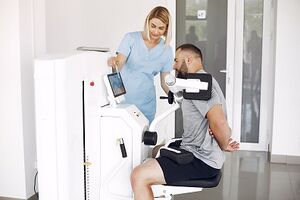Isokinetic Exercise: Difference between revisions
(Added IMAGE) |
(Text and refs inserts) |
||
| Line 3: | Line 3: | ||
== Introduction == | == Introduction == | ||
[[File:Patient-doing-exercise-using-quipment-with-therapist.jpg|right|frameless]] | [[File:Patient-doing-exercise-using-quipment-with-therapist.jpg|right|frameless]] | ||
'''Isokinetic exercise''' or '''accommodating variable-resistance exercise''', is a type of [https://www.physio-pedia.com/Therapeutic_Exercise therapeutic exercise] which refers to force exertion against the '''isokinetic machine''' that leads to limb movement at a fixed velocity. <ref name=":0">Dale B. Principles of rehabilitation. In: Andrews J, Harrelson G, Wilk K. (eds) Physical Rehabilitation of the Injured Athlete. 4th ed. 2012, 41-66. Available from: https://www.sciencedirect.com/science/article/abs/pii/B9781437724110000046 [accessed 8/7/2023]</ref> | '''Isokinetic exercise''' or '''accommodating variable-resistance exercise''', is a type of [https://www.physio-pedia.com/Therapeutic_Exercise therapeutic exercise] which refers to force exertion against the '''isokinetic machine''' that leads to limb movement at a fixed velocity. <ref name=":2">Baltzopoulos V, Brodie DA. [https://pubmed.ncbi.nlm.nih.gov/2675256/ Isokinetic dynamometry. Applications and limitations.] Sports Med. 1989 Aug;8(2):101-16. </ref> In other words, it corresponds to exercises whose limb velocity remain stable throughout the [[range of motion]], and thus, muscle force and resistance in the machine are changing to meet this requirement. <ref name=":0">Dale B. Principles of rehabilitation. In: Andrews J, Harrelson G, Wilk K. (eds) Physical Rehabilitation of the Injured Athlete. 4th ed. 2012, 41-66. Available from: https://www.sciencedirect.com/science/article/abs/pii/B9781437724110000046 [accessed 8/7/2023]</ref> | ||
Isokinetic training is widely applied to sports rehabilitation; however, there are also reports favouring the use isokinetic exercise in patients with neuromuscular diseases (NMDs) <ref>El Mhandi L, Bethoux F. [https://pubmed.ncbi.nlm.nih.gov/23051758/ Isokinetic testing in patients with neuromuscular diseases: a focused review.] Am J Phys Med Rehabil. 2013 Feb;92(2):163-78.</ref> | |||
== Types of Isokinetic Exercise == | == Types of Isokinetic Exercise == | ||
| Line 9: | Line 11: | ||
== Isokinetic Assessment == | == Isokinetic Assessment == | ||
Isokinetic machines can be used in movement assessment and [https://www.physio-pedia.com/Assessing_Muscle_Strength assessment of muscle strength] providing objective as well as | Isokinetic machines can be used in movement assessment and [https://www.physio-pedia.com/Assessing_Muscle_Strength assessment of muscle strength] providing objective and quantitative measurements as well as optimal loading of the muscle.<ref name=":2" /> | ||
Control of speed in movement assessment may provide valuable insights on individual dynamic muscle patterns while providing stability to the testing positions. <ref name=":1">Wilk K, Reinold M, Andrew J. The Athlete's Shoulder. 2nd ed. 2009. Available from: https://www.sciencedirect.com/book/9780443067013/the-athletes-shoulder [accessed 8/7/2023]</ref> | Control of speed in movement assessment may provide valuable insights on individual dynamic muscle patterns while providing stability to the testing positions. <ref name=":1">Wilk K, Reinold M, Andrew J. The Athlete's Shoulder. 2nd ed. 2009. Available from: https://www.sciencedirect.com/book/9780443067013/the-athletes-shoulder [accessed 8/7/2023]</ref> | ||
Revision as of 20:57, 10 July 2023
Introduction[edit | edit source]
Isokinetic exercise or accommodating variable-resistance exercise, is a type of therapeutic exercise which refers to force exertion against the isokinetic machine that leads to limb movement at a fixed velocity. [1] In other words, it corresponds to exercises whose limb velocity remain stable throughout the range of motion, and thus, muscle force and resistance in the machine are changing to meet this requirement. [2]
Isokinetic training is widely applied to sports rehabilitation; however, there are also reports favouring the use isokinetic exercise in patients with neuromuscular diseases (NMDs) [3]
Types of Isokinetic Exercise[edit | edit source]
Isokinetic exercises may be concentric-concentric, concentric-eccentric, or eccentric-eccentric.[2]
Isokinetic Assessment[edit | edit source]
Isokinetic machines can be used in movement assessment and assessment of muscle strength providing objective and quantitative measurements as well as optimal loading of the muscle.[1]
Control of speed in movement assessment may provide valuable insights on individual dynamic muscle patterns while providing stability to the testing positions. [4]
Muscle strength can be assessed by providing resistance by an isokinetic dynamometer throughout the range of motion at a constant velocity. This generates an isokinetic torque curve, whose highest point indicates strength of a muscle or muscle group of the targeted joint. Muscle strength can also be evaluated across differing speeds, and ranges of motion making this a useful tool for comparing the left to right side.
Assessment of isokinetic eccentric movement can be performed either by (1) setting up a predetermined load and having the lever arm drive the extremity at the predetermined velocity, or (2) working against a passively moving lever arm at the predetermined velocity. [4]
A prerequisite of high reliability of isokinetic testing is to follow the testing protocol. Collected data is in a machine-specific format and different data handling software programmes are used for different machines. [4] Thus, users need to be familiar with this type of data analysis and interpretation, which does not necessarily reflect functional patterns of performance.
References[edit | edit source]
- ↑ 1.0 1.1 Baltzopoulos V, Brodie DA. Isokinetic dynamometry. Applications and limitations. Sports Med. 1989 Aug;8(2):101-16.
- ↑ 2.0 2.1 Dale B. Principles of rehabilitation. In: Andrews J, Harrelson G, Wilk K. (eds) Physical Rehabilitation of the Injured Athlete. 4th ed. 2012, 41-66. Available from: https://www.sciencedirect.com/science/article/abs/pii/B9781437724110000046 [accessed 8/7/2023]
- ↑ El Mhandi L, Bethoux F. Isokinetic testing in patients with neuromuscular diseases: a focused review. Am J Phys Med Rehabil. 2013 Feb;92(2):163-78.
- ↑ 4.0 4.1 4.2 Wilk K, Reinold M, Andrew J. The Athlete's Shoulder. 2nd ed. 2009. Available from: https://www.sciencedirect.com/book/9780443067013/the-athletes-shoulder [accessed 8/7/2023]







